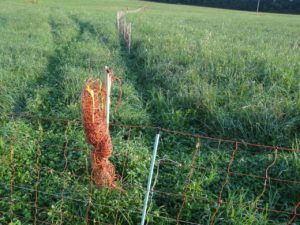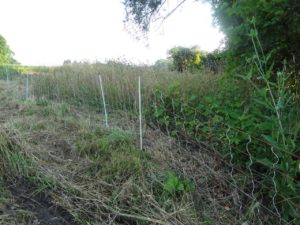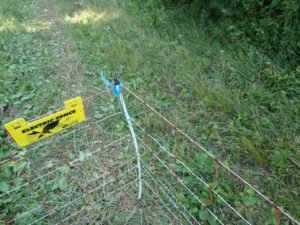Electric Nettings for Sheep: Useful Tips
Note to Reader
I wrote a previous article which appeared in the Fall 2007 issue of Small Farm Quarterly which covered basic information about electric nettings – what they are, what variations there are, what to use them for. I will not address these details in this article in order to focus on a few useful tips that I have learned over the years. This article assumes you have some knowledge of and experience with electric nettings. For a more detailed description of what they are, please refer to the 2007 article posted here.
Electric nettings, or “nettings” in short, for sheep are tremendously successful in many parts of Europe. It appears to me that they are not nearly as much in use in the US as they are overseas. During my shearing days I met many who had tried and then discontinued using them. There seems to be two main reasons for not using them: sloppy way of putting them up and not enough electricity to keep the sheep in.

A short section of netting to fill a small gap. Please also note the track to put up the nettings. All photos by Ulf Kintzel
A sloppy way of erecting the nettings can lead to sheep escaping or worse, the nettings becoming a death trap for sheep getting stuck and then electrocuted.
Erecting a nice straight line of a tight fence may take a matter of years, but straight is not needed to be functional, tight and stretched is. When I put up nettings, I hold the roll of nettings in one hand, take a post and step it in, and then move on to the next spot for the next post. This method takes some experience. It may be easier to lay out the entire fence, stretch it, and then erect the fence. You will walk twice as much but perhaps you may not get as frustrated with fence posts tangled up in the netting and/or a fence line as crooked as can be.
I strongly recommend double-spiked posts over single-spike posts because the double spike allows you to step the post in. If you have been frustrated with electric nettings and you have single-spiked posts, you may already have solved one source of your frustration. Electric nettings also come in different heights. I find 35 inches sufficient for my medium-sized sheep which are fairly calm. Nettings that are 40 inches high or even higher do not serve a purpose for me in everyday life. The downside with these higher nettings is the difficulty to erect them and keep them erected.
When fencing in a somewhat rectangular grazing cell, the corners becomes a weak part. Here is where the fence is likely to sag or the posts likely to collapse if the ground is soft. There are various ways to put tension on the corner. The easiest way for me is using a tent stake, preferably made from steel, with a bale string attached to it and a loop at the other end of same bale string. That bale string gets looped around the middle of the fence post at the corner and then the loop of the string is put over the top of the post. The string gets tightened and the spike is put into the ground as shown in the picture.
Each of my 35-inch high netting has eight horizontal strands of which seven are conductive. Each strand is not a single wire but there are multiple thin wires wrapped around a plastic strand. That means that less than five nettings equal a mile of single-strand electric fence. In fact, it can be argued that even fewer nettings equal one mile of single strand electric fence since multiple thin wires are wrapped around each plastic strand. Since many underestimate how much “mileage” you get with just a few nettings they also tend to under-power electric nettings. So even with just a few electric nettings I would recommend looking at energizers with no less than two and a half Joules. A few dozen nettings will require energizers with five or six Joules and up.
As the grass grows tall in late spring and early summer, erecting the nettings becomes more difficult for two reasons. First, in many places the netting does not go low enough. It is elevated by the grass and it leaves room for lambs to escape. Secondly, the tall grass touches hot wires in many places and drains away a substantial amount of electricity, especially when it is wet. I solve this problem by making a track with the truck beforehand, which also helps in keeping a straight line. If there are too many seed stems I use the bush hog to mow a path.
Standard electric netting comes in 50 meter (164 feet) length. When you are almost done putting them up you are often left with a small section of perhaps 20 yards or 12 or even only five. It is rather cumbersome to put up an entire netting for that section of smaller size, letting two nettings overlap. Shorter nettings of 25 meters (82 feet) are sold as well but cost far more per foot than standard nettings. I solved the problem by cutting out smaller sections from older nettings that were in part broken, ending up with nettings of all kinds of lengths. I just have to add a post and a connecting vertical conductive wire at the end, using strands from the repair kit that comes with the purchase of each netting.
Over time many bottom strings will break, especially since mice or ground hogs like to chew through them and they get caught time and again when erecting nettings. These broken sections will need to be repaired when they get to manifold in order to ensure that there are no lambs escaping by pushing underneath the fence. I tie the one end of the repair string to where it broke on one side and pull it tight on the other end, assuring that I end up with about the same length of string as before (see photo). Then I make a knot and cut off the remaining string. Vertical strings break too but I rarely fix those. The nettings remain quite functional even with a few vertical strings broken.
I use spare posts salvaged from old nettings over the years to lift wire off the ground in uneven terrain. Nettings with vertical struts prevent this from happening altogether. Yet, I prefer nettings with vertical strings since these are easier to erect and more importantly, easier to roll up. Nettings with struts are okay as long as these struts are all intact. However, once they start breaking they get caught every which way and tangle the netting up when you work with them. Spare posts work just as well for the occasional hot wire touching the ground (see photo). Likewise, the netting may go over a ditch, exposing an escape route for lambs or an entrance hole for predators like coyotes. Again, spare posts can be used to pin down the lowest, non-conductive string or a branch can be pushed through. Its weight will lower the netting without shortening the fence out.
Electric nettings are in my view the next best thing after permanent woven wire fences. Erecting them and keeping them functional can be a challenge. I hope this article has helped a little to master these challenges.




Do you know of any manufacturing co. who has and elec. net fencing?? I cannot find any on who has this product on hand.
Thanks,
Premier 1 electric netting (premier1supplies.com)